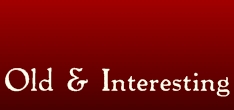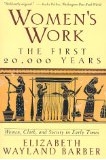-
History of:
- Resources about:
- More:
- Baby walkers
- Bakehouses
- Bed warmers
- Beer, ale mullers
- Besoms, broom-making
- Box, cabinet, and press beds
- Butter crocks, coolers
- Candle snuffers, tallow
- Clothes horses, airers
- Cooking on a peat fire
- Drying grounds
- Enamel cookware
- Fireplaces
- Irons for frills & ruffles
- Knitting sheaths, belts
- Laundry starch
- Log cabin beds
- Lye and chamber-lye
- Mangles
- Marseilles quilts
- Medieval beds
- Rag rugs
- Rushlights, dips & nips
- Straw mattresses
- Sugar cutters - nips & tongs
- Tablecloths
- Tinderboxes
- Washing bats and beetles
- Washing dollies
- List of all articles
Subscribe to RSS feed or get email updates.
[A guest in a London hotel....]
By the scent of the towels placed on his stand, screwed into a dry linen press, instead of being subjected to the washing-tub between service and service, he is able to ascertain whether his fair neighbours prefer eau-de-cologne to lavender-water....
Albany Pointz, The London Hotel-keeper, in Bentley's Miscellany, 1844
Cleaning black lace veils and black lace. These articles should be gently washed in warm water [...] then pinned to a table, covered with linen (firmly secured) until dry. [...] Some recommend mangling or pressing in a linen press after the laces are dry and unpinned.
Household Encyclopaedia, 1858

Elizabeth Barber, Women's Work: The First 20,000 Years Women, Cloth, and Society in Early Times, from Amazon.comor Amazon UK

Linen presses and napkin presses
The screw press as furniture for smoothing and displaying household linen
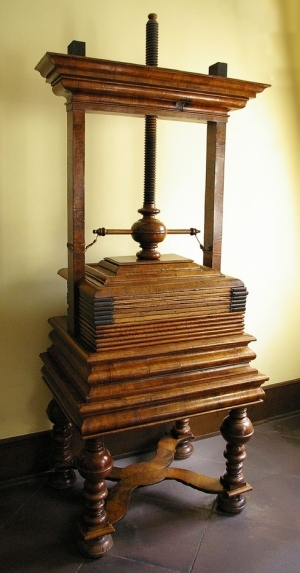 A linen press often means a big
old-fashioned cupboard where you keep household textiles, but it can also mean a
screw press for keeping linen smooth and neatly folded. This kind of press was used
by the Romans for giving a good finish to new and laundered cloth. Over the centuries
presses of this type have been used for smoothing both freshly-washed and recently-used
linen, especially table linen, which led to the name 'napkin press'. Tightening
the vertical screw puts pressure on a board sitting on top of a pile of folded cloth.
A linen press often means a big
old-fashioned cupboard where you keep household textiles, but it can also mean a
screw press for keeping linen smooth and neatly folded. This kind of press was used
by the Romans for giving a good finish to new and laundered cloth. Over the centuries
presses of this type have been used for smoothing both freshly-washed and recently-used
linen, especially table linen, which led to the name 'napkin press'. Tightening
the vertical screw puts pressure on a board sitting on top of a pile of folded cloth.
Ornate carved presses were more than functional. They were a good way of displaying your best white cloths and napkins in a fine piece of furniture, and this was particularly true in 17th and 18th century Europe and North America. Often called napkin presses, they were kept near the dining table - for show and for convenience. Plainer presses might be in a pantry or laundry room. See one press with very elaborate carving from Wawel Castle in Poland, or this drawing of a plain press.
The pressure on the cloth does more than flatten it. It may give linen a slight sheen, and it emphasises the folds. So folding linen neatly in a regular pattern was important and could even be decorative, as in the medieval tablecloth shown at the bottom of this page. Folding along the old creases when putting a tablecloth back in the press after a meal was important - as Victorian servants' advice manuals insist.
Having shaken the breakfast cloth, folded it in exactly the same folds as it had at first, and put it into the napkin press, she will next proceed to have her own breakfast...
Common Sense for Housemaids, 'By a Lady', 1853
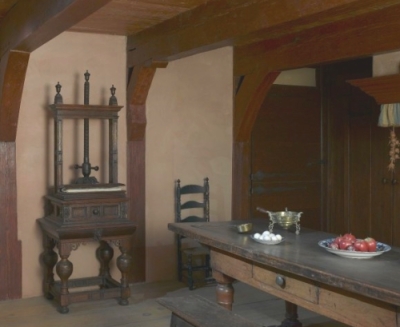 Inventories and wills on both
sides of the Atlantic often mention napkin presses during the 17th and 18th centuries.
This was the period that produced the two presses in the photographs here - a German
linen press from Goethe's late 18th century house (above), a c1675 press from Brooklyn,
NY (left) - and this press from the early
1600s. They were still being
made in the 19th century.
Inventories and wills on both
sides of the Atlantic often mention napkin presses during the 17th and 18th centuries.
This was the period that produced the two presses in the photographs here - a German
linen press from Goethe's late 18th century house (above), a c1675 press from Brooklyn,
NY (left) - and this press from the early
1600s. They were still being
made in the 19th century.
Inventories from 1707 and 1712
The halle: a dozen chairs £4 16s, a paire of tables 8s, a napkin press £1 10s, 2 glass sconces 9s
In the stair case: One table 1s 6d, Ten chares 3s 6d, One napkin press 1s 6d
Hylton Castle, Durham, England, 1707
In the Haull: a "napkin press of wallnut" valued at 3 pounds and an "oke table ovoll" valued at 2 pounds
Boston merchant who died in Rhode Island in 1712
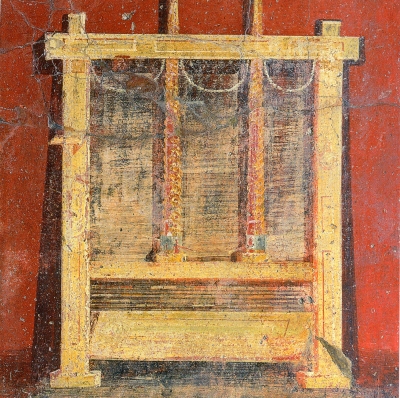 We can see how similar the presses used by textile workers in ancient Rome were.
A mural from Pompeii (see right) shows a press with two screws set in a frame. The
remains of a single-screw (cochlea)
press from Herculaneum are preserved in a plexiglass case. These presses
were part of the fulling process for newly-woven cloth, and were also used to give
a good finish to togas that were sent to "the cleaners" (fullonica) for laundering.
They are sometimes called clothes presses, but are more suitable for clothing based
on straight lengths of cloth, like a Roman toga, than for delicate or fitted garments.
We can see how similar the presses used by textile workers in ancient Rome were.
A mural from Pompeii (see right) shows a press with two screws set in a frame. The
remains of a single-screw (cochlea)
press from Herculaneum are preserved in a plexiglass case. These presses
were part of the fulling process for newly-woven cloth, and were also used to give
a good finish to togas that were sent to "the cleaners" (fullonica) for laundering.
They are sometimes called clothes presses, but are more suitable for clothing based
on straight lengths of cloth, like a Roman toga, than for delicate or fitted garments.
Pressing then gave the cloth a smooth, lustrous surface. For this purpose the Romans used the screw-press invented in the days of Pliny. The cloth was carefully folded backwards and forwards and placed between the plates. The left- and right-hand threads of the upright screws facilitated equal tightening. Before pressing the cloth was usually sprinkled with water held in the mouth of the bleacher.
Robert James Forbes, Studies in Ancient Technology: The Fibres and Fabrics of Antiquity, Volume 1
COCHLEA ... which properly means a snail, was also used to signify other things of a spiral form....[like] a screw. The woodcut annexed represents a clothes-press, from a painting on the wall of the Chalcidicum of Eumachia, at Pompeii, which is worked by two upright screws (cochleae) precisely in the same manner as our own linen presses...
Article by Anthony Rich, Jun. B.A. in the Dictionary of Greek and Roman Antiquities, John Murray, London, 1875, ed. William Smith, D.C.L., LL.D.
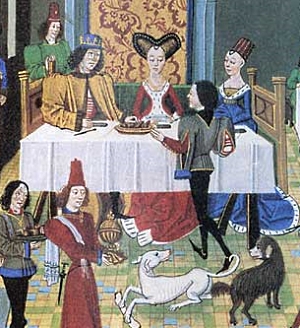
Illustrated left: Detail from painting of a medieval banquet where the top table has a cloth with clear fold lines of the kind made by a screw press.
 24 May 2010
24 May 2010
You may like our new sister site Home Things Past where you'll find articles about antiques, vintage kitchen stuff, crafts, and other things to do with home life in the past. There's space for comments and discussion too. Please do take a look and add your thoughts. (Comments don't appear instantly.)
For sources please refer to the books page, and/or the excerpts quoted on the pages of this website, and note that many links lead to museum sites. Feel free to ask if you're looking for a specific reference - feedback is always welcome anyway. Unfortunately, it's not possible to help you with queries about prices or valuation.
